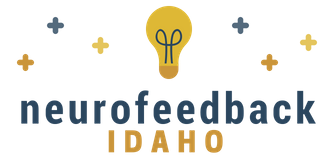A New Approach
For over 40 years the accepted treatment for neurological symptoms has been the use of medications. However the disadvantages to medicating the brain are becoming more widely known. Side effects are common, and stopping the medication often results in a return of the symptoms. Patients are becoming increasingly frustrated with high cost medications that do not offer a long term resolution to their symptoms. There are other ways to change the brain that are non-invasive and more natural. It’s no secret that the food you eat and exercise are all critical to brain function. But this is often not enough to alleviate more serious conditions.
Introducing Neurofeedback
What if you could eliminate or reduce chronic neurological conditions just by watching a movie or listening to music? It may sound too good to be true, but with the rise of computer technology, combined with decades of research in understanding brainwaves and how they affect your health, it is now possible to “fix” brainwaves and affect the way the body functions.
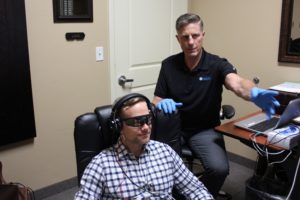 This new field, called Neurofeedback, is yielding positive results for many people with debilitating neurological symptoms. Neurofeedback has been shown to be incredibly powerful when done right with a licensed practitioner. There are many case studies of people who have changed their lives for the better using neurofeedback. Research has shown people of all ages see dramatic improvement in ADHD, Depression, Anxiety, Brain Injury, Migraines, Seizures, Chronic Pain, Addiction and more. Results like these have become too common to ignore. Neurofeedback is not an instant process. It takes time for the brain to change and learn. Often many sessions are needed to see any results. But often, once clients are functioning better and have fewer symptoms, they can reduce or eliminate their reliance on medication. Neurofeedback has been proven to change the brain – to change timing in the brain. It’s published in scientific literature. It’s used by thousands of licensed health professionals around the world. It could be the most important new tool available for mental and neurological health.
This new field, called Neurofeedback, is yielding positive results for many people with debilitating neurological symptoms. Neurofeedback has been shown to be incredibly powerful when done right with a licensed practitioner. There are many case studies of people who have changed their lives for the better using neurofeedback. Research has shown people of all ages see dramatic improvement in ADHD, Depression, Anxiety, Brain Injury, Migraines, Seizures, Chronic Pain, Addiction and more. Results like these have become too common to ignore. Neurofeedback is not an instant process. It takes time for the brain to change and learn. Often many sessions are needed to see any results. But often, once clients are functioning better and have fewer symptoms, they can reduce or eliminate their reliance on medication. Neurofeedback has been proven to change the brain – to change timing in the brain. It’s published in scientific literature. It’s used by thousands of licensed health professionals around the world. It could be the most important new tool available for mental and neurological health.
What is Neurofeedback?
Neurofeedback (also called Neuro Therapy) is a non-invasive process where brain waves are monitored in real time by a computer, which can then use that information to produce changes in brainwave activity. The process of adjusting brainwave activity is known as operant conditioning, which is a method where rewards for positive behavior increase learning capabilities.
The Neurofeedback Process
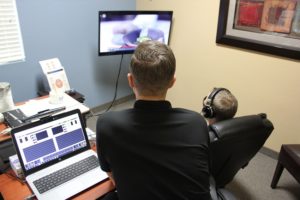 The computer monitors your brainwaves while you watch a movie or listen to music. When deviations from normal brainwave activity occur, the computer triggers an audio or visual cue that alerts the patient that they are outside normal ranges. These cues are received by the brain, which subconsciously adjusts itself back to a normal pattern to make the cue stop. With enough repetition of this process, the brain eventually learns to stay in the normal ranges on its own without the computer. With the brain functioning normally on its own, symptoms of irregular brain activity will decline.
The computer monitors your brainwaves while you watch a movie or listen to music. When deviations from normal brainwave activity occur, the computer triggers an audio or visual cue that alerts the patient that they are outside normal ranges. These cues are received by the brain, which subconsciously adjusts itself back to a normal pattern to make the cue stop. With enough repetition of this process, the brain eventually learns to stay in the normal ranges on its own without the computer. With the brain functioning normally on its own, symptoms of irregular brain activity will decline.
It has been well documented that people who suffer neurological problems have abnormal brain waves in certain areas of the brain. For instance, case studies using QEEG “brain maps” have shown that people with Attention-Deficit-Disorder (ADD) have elevated delta brainwaves, while those who suffer from depression have elevated alpha brainwaves. Those with anxiety will have elevated Beta brainwaves, while those suffering from memory loss usually have decreased theta brainwaves.
Training the brain using neurofeedback can change these brainwaves over time, adjusting them into normal, healthy ranges. It can improve alertness, attention, emotional regulation, behavior, cognitive function, and mental flexibility. When the brain moves back into normal ranges, users will often see a reduction in symptoms.
The best part of neurofeedback is that results are often permanent, allowing a person to reduce or even eliminate medications altogether. Where medications only manage the symptoms, the goal of neurofeedback is to address the underlying cause and restore normal brainwave functions.
The Brain Is A Learning Machine
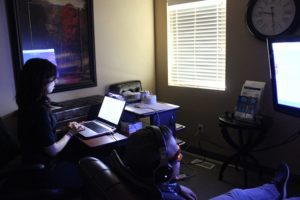 Through operant conditioning, the brain is rewarded when the audio or video returns to normal. Eventually the brain learns to stay in the healthy ranges without the reward stimulus, and is able to sustain normal activity independent of the computer. This is achieved by reconnecting functional pathways in the brain. Neurofeedback does not target any particular disorder. Its purpose is to change timing and activation patterns in the brain. This improves brain regulation, which can impact a variety of symptoms. Different symptoms will require triggering different areas of the brain. The software is designed to target specific areas of the brain according to a patient’s symptoms.
Through operant conditioning, the brain is rewarded when the audio or video returns to normal. Eventually the brain learns to stay in the healthy ranges without the reward stimulus, and is able to sustain normal activity independent of the computer. This is achieved by reconnecting functional pathways in the brain. Neurofeedback does not target any particular disorder. Its purpose is to change timing and activation patterns in the brain. This improves brain regulation, which can impact a variety of symptoms. Different symptoms will require triggering different areas of the brain. The software is designed to target specific areas of the brain according to a patient’s symptoms.
How Many Sessions Are Needed?
There is no magic number. Just as every person is unique, the number of sessions will vary according to each person. Noticeable results typically occur between the first and tenth session. In general 20 – 40 sessions are needed for the results to become permanent. Symptoms in some patients will resolve in a shorter time. Some require more training, some less. The goal is to complete enough sessions to ensure consistent and lasting benefits. A brain map can be generated at any time between sessions, so that you can visually see the progress your brain is making.
What Is Brain Mapping?
 The brain is a highly complex organ made up of billions of cells called neurons. Neurons send and receive messages to and from all parts of your body. These messages are electrical impulses that create brain waves. The brain map (also called a neuro map) is an important tool we use to evaluate your brainwaves and identify opportunities to improve communication between various regions of the brain. The brain map is able to capture a window of brain activity, analyze the data, and create a visual representation for each lobe of the brain and each specific brain wave (Delta, Theta, Alpha, Beta).
The brain is a highly complex organ made up of billions of cells called neurons. Neurons send and receive messages to and from all parts of your body. These messages are electrical impulses that create brain waves. The brain map (also called a neuro map) is an important tool we use to evaluate your brainwaves and identify opportunities to improve communication between various regions of the brain. The brain map is able to capture a window of brain activity, analyze the data, and create a visual representation for each lobe of the brain and each specific brain wave (Delta, Theta, Alpha, Beta).
How Does Brain Mapping Work?
Using a cap placed on the scalp, our software captures the electrical impulses in the brain. This method is known as an electroencephalogram (EEG). The results show brain wave patterns in different parts of the brain. The process takes about 15 minutes, and the data is then converted into a visual brain map report. We analyze the brain map report and identify any problem areas. The report will display the results in a clear and concise format that can be easily understood.
The Brain Map Report
Here are several pages from the brain map report:

Delta Brainwave
Sleepy, Dreaming

Theta Brainwave
Drowsy, Meditative

Alpha Brainwave
Relaxed, Reflective

Beta Brainwave
Alert, Working
How Does Brain Mapping Work?
Using a cap placed on the scalp, our software captures the electrical impulses in the brain. This method is known as an electroencephalogram (EEG). The results show brain wave patterns in different parts of the brain. The process takes about 15 minutes, and the data is then converted into a visual brain map report. We analyze the brain map report and identify any problem areas. The report will display the results in a clear and concise format that can be easily understood.
The Brain Map Report
Here are several pages from the brain map report:
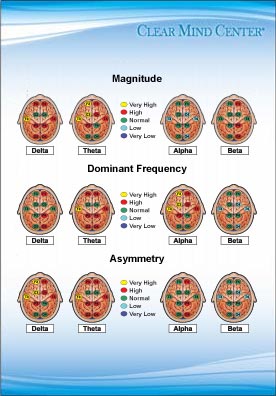
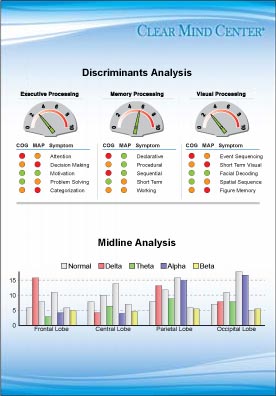

This page shows an analysis of each lobe of the brain (frontal, parietal, central, temporal and occipital) for each type of brain wave: Delta, Theta, Alpha, Beta. Green indicates a normal level, red is elevated and yellow is extreme.
The Discriminants Analysis page (below) shows a visual meter for the major functions of the brain, such as the cognitive, emotional, memory processing, executive functions, and more.
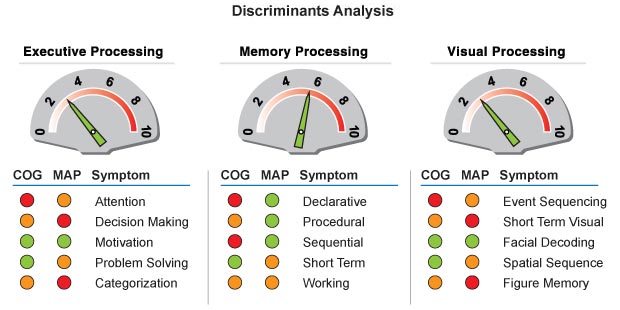
The Emotional and Cognitive Analysis compares the results of your self-assessment against the results of the brain map and helps identify problem areas within the brain. Red indicates a strong potential match, green indicates no match.

The Midline Analysis is a visual reference of your brainwaves compared to normal ones. Gray bars are normal levels, color bars are from your brain map.
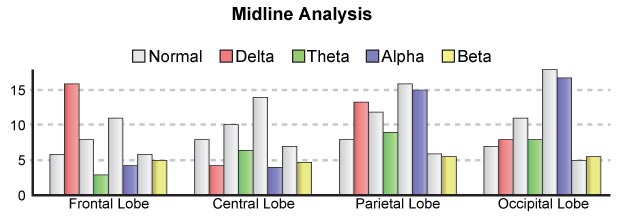
Based on the results of your brain map, the report will generate suggested protocols for training your brain back into normal ranges, as well as suggested supplements.

The brain map is a revolutionary new tool in accurately identifying the problem areas of the brain. It takes the guesswork out of the assessment process and provides an accurate road map for improving your health and well being.
